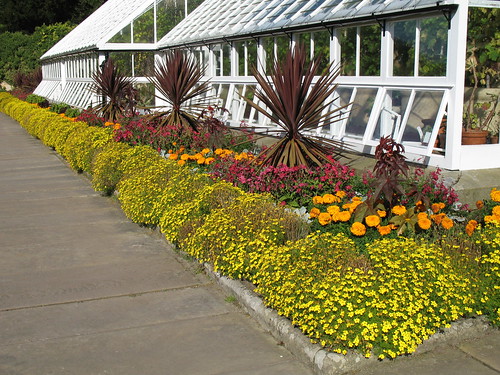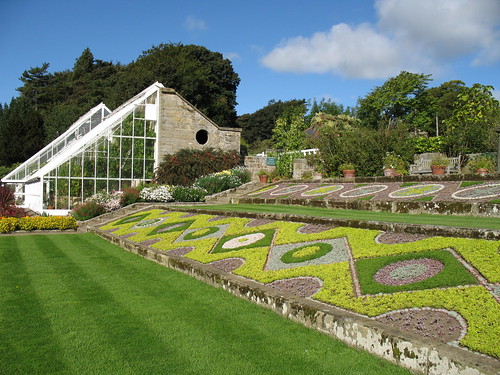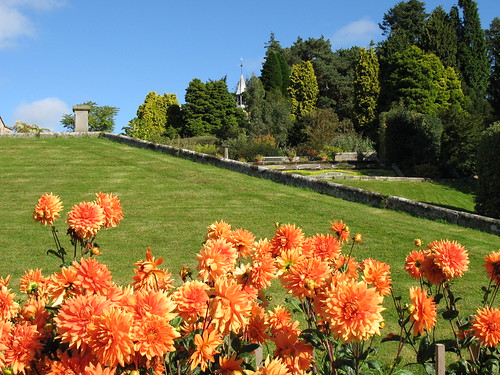The orchard house is a very fine structure and is quite a distinctive landmark in the surrounding district. It is thought to have been designed by Lord Armstrong in the 1870’s. It has a timber base and cast-iron glazing bars in the roof. It was built to for hardy and tender fruits in order to give them protection from the Northumberland climate.
The carpet bedding can be found next to the orchard house and in summer months is planted with diminutive foliage plants in geometric patterns. The plants are clipped fortnightly using sheep sheers to form a flat carpet like surface. Each bed requires 10,000 plants which are raised in the nursery at Cragside. During autumn the beds are planted with tulips, pansies and polyanthus in order to provide spring colour.
The last photograph is taken from the Dahlia walk and you can just see the carpet bedding in the background. Behind that the clock tower peeps out from in amongst the trees.
The clock tower originates from the 1860s and was the estate time piece and the pay office. Staff received their weekly pay in small, numbered, timber boxes about 4in (10cm) square. At the peak of construction there were more than 300 staff working at Cragside: gardeners, stone masons, carpenters, gamekeepers and labourers, all working a twelve-hour day. Under the watchful eye of William Bertram, the Estate Manager, this simple system ensured that all were properly paid. *
*From Cragside Garden Leaflet.











Those are very immaculate gardens. I promised myself a visit to the Dahlia garden at Anglesey Abbey, but I think I am too late now.
I hadn’t heard of Anglesey Abbey so I checked it out. It looks a wonderful place and is now on my wish list of places to see.
You may not be too late for the Dahlias, they were still blooming at Chartwell when I went over the weekend.
Staff received their weekly pay in small, numbered, timber boxes about 4in (10cm) square.
Interestingly, so did we even into the 90s. Called them pigeon holes.
I remember receiving my pay in a paper packet which was stapled. We were expected to count the money before removing the staple in case of discrepancies.
A few years later when I worked in the personnel department I was on the roster for counting the pay for the industrial staff who still received their pay in this way. All the packets were then put in a wooden box with a key for safety whilst the pay packets were delivered to each building. I always wondered why people thought it was safe in a cronky wooden box…
These grounds are just phenomenal. A lot of upkeep involved to keep them so beautiful.
It is a lovely place to visit
Hm, difficult choice – but of the three, I think I favour the last pic: that glorious burst of orange in te foreground = just beautiful! Am so enjoying the virtual visit, Cherie.
The last one is my favourite too
I am so glad you are enjoying the visit.